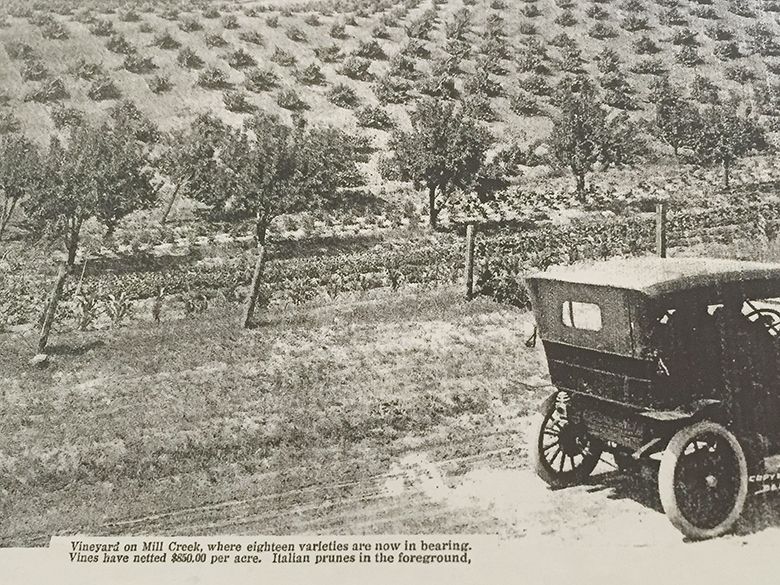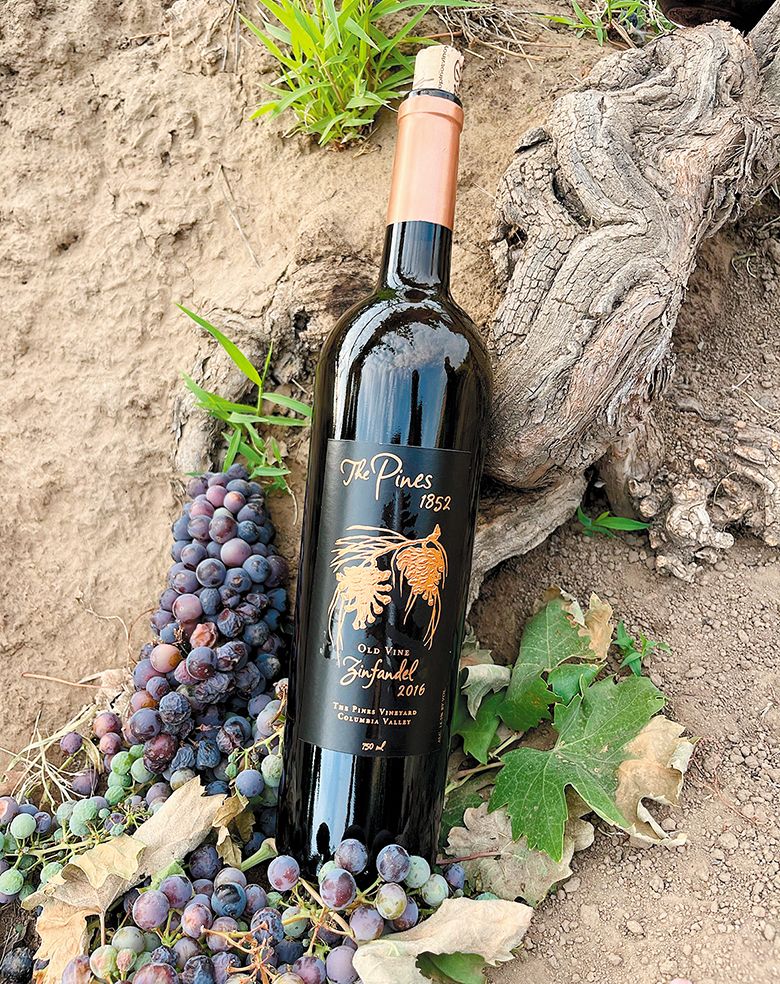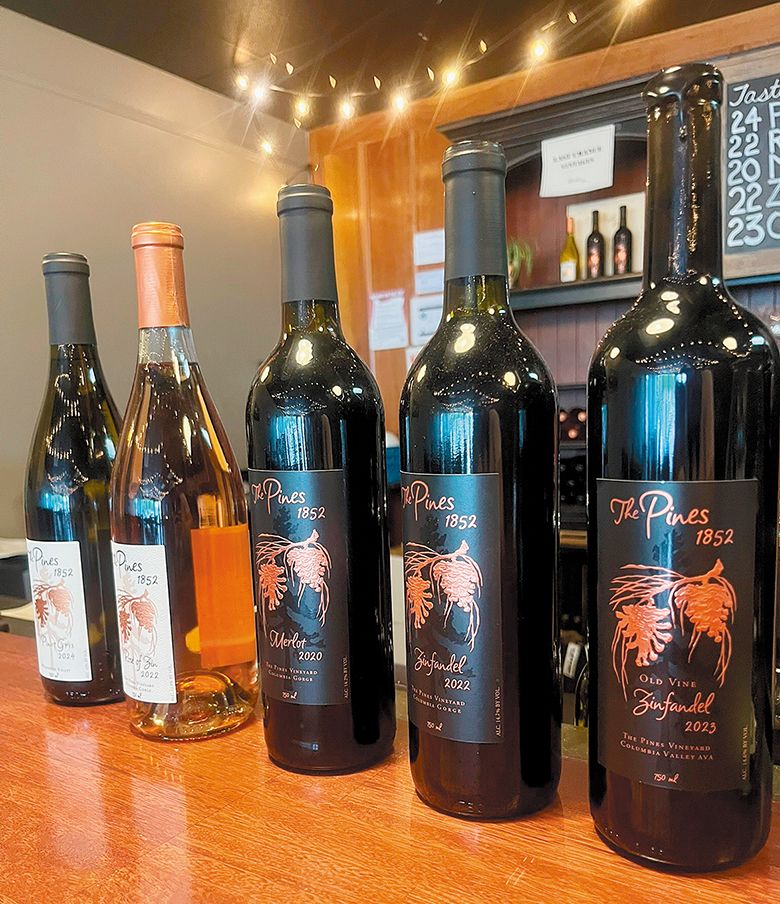Back to Life
Read the story behind old vines thriving in the Columbia Gorge





By Annelise Kelly
Oregon has deep roots in wine, few deeper than at The Pines 1852.
Visionary pioneers Richard Sommer and David Lett planted vineyards in the 1960s, but those venerable plants are half the age of the oldest grapevines currently thriving in the Columbia Gorge, stewarded by Lonnie Wright.
In 1982, while vintners were collaborating to establish Oregon’s first American Viticultural Area, Wright was busy restoring his historic vineyard. The success of those grapevines led him to plant additional blocks on his Mill Creek Valley property, located five miles southwest of The Dalles. Initially, Wright sold all his grapes. However, in 2001, he launched his own label, The Pines 1852, and now keeps about half the fruit he grows.
THE "WRIGHT" PLACE AT THE RIGHT TIME
After graduating from college in Indiana, Wright and a friend piled into his old Ford to seek their fortune. It was 1972. Their journey around the country exposed them to agricultural work, and Wright developed experience in pivot irrigation– the technology responsible for those enormous green circles seen from 30,000 feet over Eastern Oregon and Washington.
In 1978, he joined a team in Paterson, Washington, that planted 2,000 acres of grapes, establishing the first vineyards at Columbia Crest Winery, owned by Chateau Ste. Michelle. Wright worked under two experts in vineyard management, learning all he could about establishing thriving grapevines. He was soon supervising the first harvest as area manager of 650 vineyard acres.
After three years at Columbia Crest, Wright and his new bride, Linda, moved to Hood River, where she longed to return. Wright took his pivot irrigation expertise to Libya for a few brief stints, returning in 1982 to determine his next steps in the Columbia Gorge.
When he learned a local orchardist had stumbled upon eight acres of Zinfandel vines near The Dalles, he thought there might be a role for him. “Ste. Michelle was the first vineyard in the Paterson area,” recalls Wright. “I noticed it must be a big deal; they were on the front end of something. I figured I’d better pay attention.” This seemed to him like another potential “front end” opportunity.
Wright arrived unannounced at the property, finding desiccated vines that had been neglected for 18 years and an orchardist relying on a textbook to direct his pruning crew. He made himself useful. Recognizing an unmet need, Wright launched his vineyard management company, Columbia Country Vineyards, in 1983.
Four years later, Wright planted a new “heritage” block of Zinfandel using cuttings from the old vines. His family moved onto the leased property, known as The Pines Dairy (it was a dairy operation from 1926 to 1941), before purchasing the land in 2002.
Between growing at The Pines, while also managing and harvesting 200 vineyard acres, Wright was simultaneously cultivating grapes and expertise.
HISTORY OF THE PINES
The exact origins of the notable vineyard are lost to history, but Wright has uncovered some facts and photos.
It was originally planted by Louis Comini, an Italian stonemason who worked on The Grotto, a Catholic shrine in Portland. He also made headstones at the local Catholic cemetery and built two stone houses in The Dalles. Wright doesn’t know whether the original Zinfandel cuttings came from Italy or California.
He has yet to find records establishing the exact year the grapevines were planted. However, Wright has some photos, and in an email to Oregon Wine Press, he states, “These pictures were published in 1911 by Union Pacific Railroad and The Dalles Civic Club (Chamber of Commerce). They were trying to entice people to come out here on the railroad and ship grapes back east. I felt like these vines looked pretty mature in 1911. That’s why I think they were planted sometime between 1890 and 1900.”
He’s spoken with locals who lived in Mill Creek Valley and walked through the vineyard in the 1920s. After speaking with Louis Comini’s son, Wright shares, “He says his earliest memory is his dad taking him out of elementary school in the 1930s to help harvest Zinfandel at The Pines Dairy, the namesake for our vineyard.”
The first time Wright visited the vineyard, the vines were hardly recognizable. They had barely survived years of neglect and were head-trained on the ground rather than trellised.
“When people began growing grapes here, they thought they would freeze. The old vine was planted where it was head-trained on the ground and could be covered with snow in the winter, so it wouldn't freeze out. And they're on their own roots,” explains Wright. “I'm the first person to bring it up on a trellis. I don't think we could have quality wine without that. Zinfandel lends itself to bunch rot. If it's on the ground, even the morning dew would be hard to get past in terms of bunch rot.”
Freezing is rare, Wright reports, “The vines have made it through winter just fine except for three years. No problems until 1991 and 1996 when temperatures dropped to minus 13 degrees Fahrenheit. The plants froze to the ground each of those years. Luckily, because they are own-rooted, we were able to train a sucker back up to the wire, resulting in a half crop the following year and a full crop the year after. We went 28 years before the next damaging frost. Then, in 2014, it went from 50 to two degrees above zero on November 10, the first frost of the fall. For the next two years, we trained new trunks up to the wire, replacing about 50 percent of the damaged trunks. That’s why we don't have huge trunks like they do in the Sonoma Valley. While the roots have been there for over a hundred years, if you look at the heads on the ground, they compare with the trunks found in Sonoma.”
THE VINEYARD AND WINERY
Washington’s Columbia Valley American Viticultural Area, or AVA, was established in 1984, so Wright was indeed on the front end of something big.
Twenty years later, when local winemakers petitioned to establish the Columbia Gorge AVA, “it's interesting because the boundary divides my vineyard,” explains Wright. “They had just put it out on email, where you could see the map. And everybody was so excited over here. I really didn't want to be the guy slowing down the petition process, so I left it there. That’s why my old vine Zinfandel is actually in the Columbia Valley AVA while the rest of my vineyard is located within the Columbia Gorge AVA.”
In the beginning, Wright grew and sold The Pines 1852 vineyard grapes while also caring for other vineyards under his management company. In addition to the original block of Zinfandel, about seven acres, he’s planted his heritage Zinfandel, as well as Merlot and Syrah.
He began making wine in 2001, under his own label with help from Sineann owner and winemaker Peter Rosback, who remained his main winemaking partner for the first 15 years. Today, Boyd Teegarden at Natalie’s Estate Winery collaborates with Wright on The Pines 1852 wines and also buys grapes from the old zin block. Wright sells fruit to Laurel Ridge Winery, Roots Wine Co. and Lady Hill Winery, too.
Teegarden feels the old vines give the wine extraordinary depth. “There’s such a long lingering finish. Tasting the old vine Zinfandel next to the 40-year-old heritage zin demonstrates how much more length and complexity there is in the old vine wine.”
He also sings the praises of Wright’s Merlot grapes. Teegarden raves, “I would put that Merlot against any in the Northwest. It is exceptional, with more depth and structure– and better acid.”
Teegarden admires Wright’s foresight in rejuvenating the old vineyard, “and his dedication to what it takes to preserve an old vineyard in a harsh climate.”
Wright has unquestionably earned the Lifetime Achievement Award from the Oregon Wine Board, bestowed on him in 2014.
Try these wines 25 miles from the legendary old vineyard, at The Pines 1852 tasting room in downtown Hood River. Live music accompanies the wine three days a week. Wright says Thursday afternoons usually feature a solo artist, Friday evenings generally host a blues or dance band and solo artists or duos typically perform on Sunday afternoons. The Pines Dairy is also available for weddings and events.
Over 40 years ago, on a hillside in the Columbia Gorge, some forgotten, yet resilient old vines got lucky.
So did we.
Thanks to the talent, dedication and dream of Lonnie Wright, today we can savor wine with roots reaching into the final decades of the 19th century.
The Pines 1852
415 Oak St., Hood River
Open Mon. noon-5 p.m., Thurs. noon-6 p.m., Fri. noon-9 p.m. (live music 6-9), Sat. noon-7 p.m. and Sun. noon-6 p.m.
(541) 993-8301
www.thepinesvineyard.com
After living in Denmark, the Netherlands, L.A. and the Bay Area, writer Annelise Kelly settled in Portland, where she delights in food carts, Douglas firs, dancing and getting crafty. Thanks to Annelise’s broad interests, her career path has weaved through cooking, events, technical writing, decorative painting and retail display.Wanderlust takes her across borders and oceans every chance she gets. Connect with Annelise at www.annelisekelly.com.










